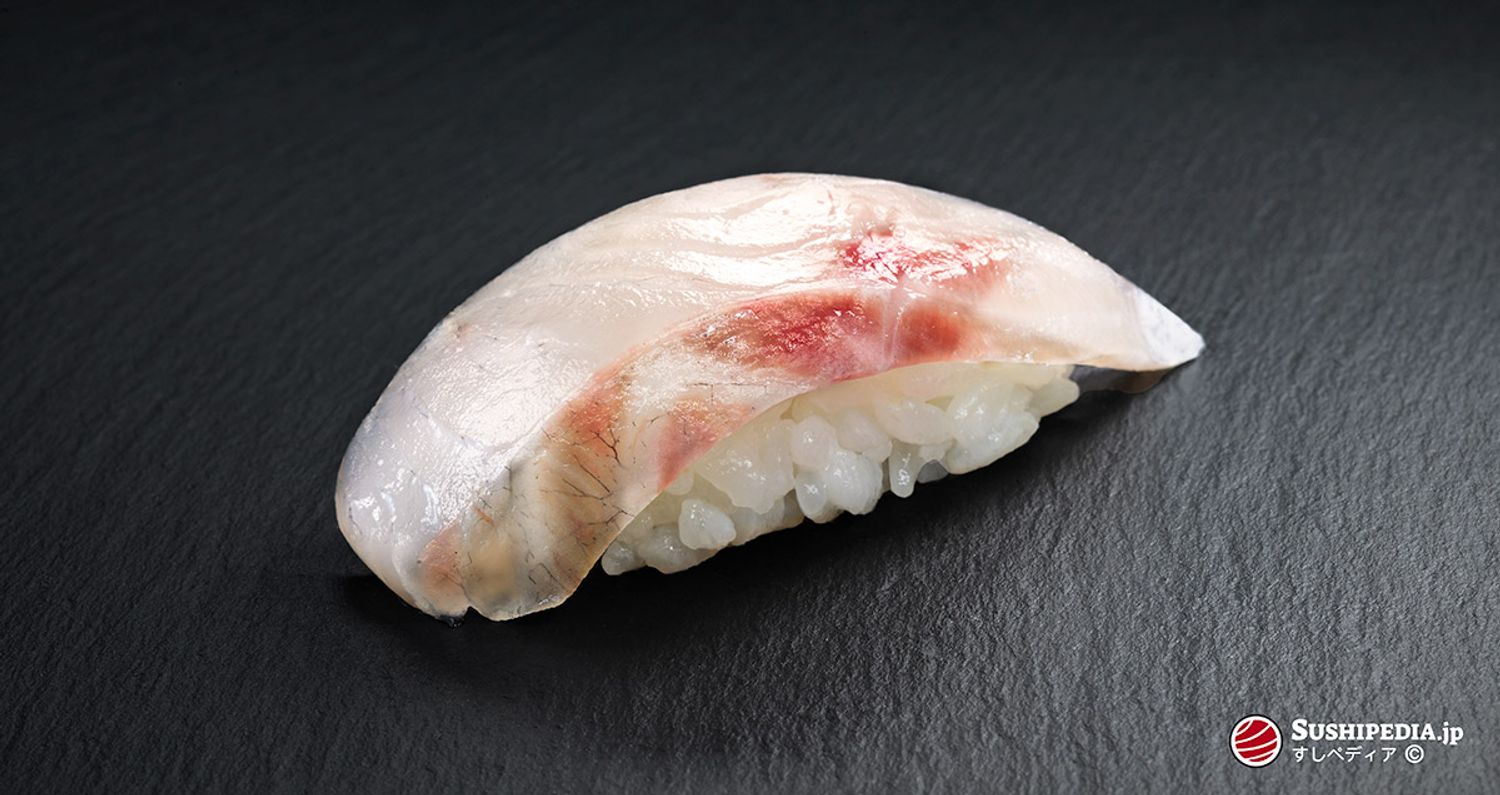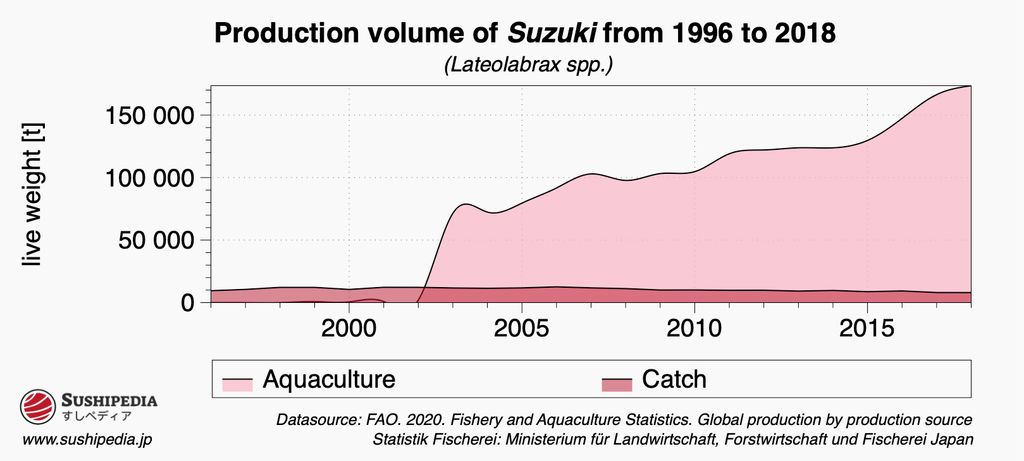Suzuki Sushi
A Comprehensive Overview of Sea Bass in Japanese Sushi Cuisine
スズキすし 、 鱸寿司 
What is Suzuki?
Suzuki 鱸 is the Japanese name for the Japanese sea bass (Lateolabrax japonicus), a fish species from the perch order. This species is found in the Western Pacific and in coastal rivers. Suzuki is a traditional ingredient in edomae sushi and an essential part of many dishes in Japanese cuisine.
It should be noted that there are also several species of fish in Japan that also bear the name suzuki. In a broader sense, the name can be applied to all fish of the genus Lateolabrax, a taxonomic category. Outside Japan in particular, people often use closely related but also less closely related fish species to prepare suzuki sushi or sashimi, for example. If the English term “seabass” is taken into account as a basic selection criterion for other fish species, the range of potential substitutes expands considerably. However, this practice bears no relation to traditional Japanese cuisine. It is not only systematically incorrect, but also linguistically misleading. In Japanese, the term “seabass” is translated as shībasu, a direct transliteration from English. The European seabass (Dicentrarchus labrax), which is primarily referred to as yōropian shībasu, is something of an exception. However, due to its external similarity, it is also known as yōroppa suzuki in Japan, although it is only distantly related to the genus Lateolabrax.
Suzuki for Sushi or Sashimi
The white flesh of suzuki is remarkably light and almost bloodless, yet firm and tender. The fish is characterized by a light and refreshing, unmistakable taste, which makes it one of the preferred fish in summer. In addition to its excellent suitability for sushi and sashimi, suzuki is also ideal for arai. In this preparation method, the raw meat is sliced very thinly, treated in ice water and then served with soy or a light miso vinaigrette.
Suzuki caught in rivers or brackish water of dirty or polluted rivers should be avoided. Not only does the meat have a bad odor and miserable taste. In general, aquaculture suzuki have been reported to have a softer texture and milder flavor than wild fish, due to differences in muscle structure and the composition of nutrients fed to the farmed fish.[1]
For specimens whose meat is softer and has a higher water content, the quality of the meat can be improved by treating it with kombu-jime. It is a traditional Japanese method in which the meat is placed between layers of kombu (a type of seaweed). This technique allows the seaweed to draw moisture out of the meat and at the same time transfer flavors from the kombu. This leads to a firmer texture and a more intense flavor, which intensifies the culinary result.
Best Season
There are also suzuki that are caught in autumn, particularly from Aichi Prefecture. However, these are rated lower in both flavour and price than those caught in summer. The taste of suzuki caught in autumn is considered less pronounced, which is also reflected in their lower market value. This is due to the fact that these fish are often caught shortly after spawning, when their energy and fat reserves for the reproductive process have already been used up. In some regions, suzuki that have migrated to offshore bays to spawn in winter are caught and therefore considered winter fish and called kan suzuki 寒 スズキ. Individuals that have not spawned at this time are considered prime specimens and fetch high prices on the market.
Suzuki in Japan
There are different theories about the origin of the name suzuki, one of them says that the name is derived from the Japanese term susugi (ススギ). Susugi is the Japanese word for rinse and is a metaphor for the white and clean-looking flesh of the suzuki, which looks as if it has already been washed out.
A Fish That Changes its Name
Suzuki is a fish that changes its name when it grows (shusseuo 出世魚). The custom has its origins in the Edo period and was part of the ceremonial rite of passage into adulthood. At that time, it was common for aspiring warriors and scholars to change their names when they rose to the rank.
In the Kanto region, a young specimen between 20 and 30 cm in size is called a seigo, while individuals between 40 and 60 cm are called fukko. Fish that reach a size of over 60 cm are called suzuki. The situation is similar in the Kansai region, where fish up to 30 cm are also known as seigo, those between 40 and 60 cm as hane and those over 60 cm as suzuki. In the Tokai region, fish up to 60 cm are known as fukko and those over 60 cm as suzuki. In the area around the Ariake Sea, in Saga Prefecture, the smallest fish up to 20 cm are classified as hakurako, those between 20 and 40 cm as hakura, those between 40 and 60 cm as hane and those over 60 cm, as in the other regions, as suzuki.
Suzuki as a Symbol of Happiness: An Anecdote From the Tale of the Heike
In the “The Tale of the Heike” (Heike Monogatari 平家物語), an epic work that describes the power struggle between the Minamoto (Genji) and Taira (Heike) clans at the end of the 12th century in Japan, there is a remarkable anecdote. It links Taira no Kiyomori, a key figure of the late Heian period and governor of Aki, with a suzuki. During a pilgrimage to Kumano, an important religious site, a suzuki unexpectedly jumped into his boat. The suzuki, regarded in Japan as a symbol of career advancement and success, was seen by Kiyomori as a good omen. A person close to him commented: “It is indeed a favourable omen. It is said that he jumped on the ship of the Wu King of Zhou (China) a long time ago and from then on won battles and attained the kingdom of heaven. This must be the blessing of Kumano Gongen.” His joy at this event was great. Later, when Kiyomori gained undisputed power over the entire country, the idea that the suzuki was indeed an auspicious fish was confirmed.[2][3]
Characteristics & Ecology of Suzuki
Suzuki prefers rocky coastal regions which are exposed to strong currents and swell. In winter, they spawn and hibernate in bays and estuaries influenced by the open sea. Suzuki are hermaphrodites (double sexed individuals), which reach sexual maturity as males and change to the female sex in the course of their life.
The distribution area stretches from the coasts of the Japanese archipelago from southern Hokkaido to Kyushu, as well as in the east and south of the Korean peninsula. Suzuki is considered to be predominantly nocturnal and feeds on small fish and crustaceans.
Species of Suzuki
In addition to L. japonicus, there are two other relatives of his genus. L. maculatus, known in Japanese as tairiku suzuki, was until recently considered to be the same species as suzuki. It is believed that specimens of tairiku suzuki escaped from Chinese breeding facilities in the 1990s and have since become established in Japan. Due to concerns about habitat competition with suzuki and other fish, tairiku suzuki was classified as a non-native species under the “Law on the Prevention of Damage to Ecosystems by Certain Alien Species” (平成十六年法律第七十八号特定外来生物による生態系等に係る被害の防止に関する法律). L. latus, whose Japanese name is hira suzuki, is also a popular edible fish and is prized for the preparation of sushi and sashimi.
Economy of Suzuki
The main Japanese fishing grounds of suzuki are Tokyo Bay, Ise Bay, the Seto Inland Sea and Lake Ariake, where they are caught mainly with bottom-set gillnets. Since the mid-2000s, large quantities of tairiku suzuki have been bred in aquaculture in China, Taiwan and South Korea.

SushiPedia. Total catch figures for Suzuki (Japanese perch) 1996-2018. All rights reserved ©
Season Calendar for Suzuki
The calendar shown does not provide information on fishing times, but marks the periods in which suzuki is considered particularly tasty.
Warnings related to Suzuki
Video about Suzuki Sushi
External video embedded from: youTube.com. Credit さばけるチャンネル. 鱸(すずき)のさばき方 - How to filet Japanese Seaperch -|日本さばけるプロジェクト.
Species of Suzuki
The following species are regarded as authentic suzuki. Either historically, according to the area of distribution or according to the common practice in today's gastronomy:
In the following, those species are listed that can be considered as substitutes for authentic species with regard to suzuki. This can be based either on their genetic relationship or on their similarity in taste and appearance. The selection is subjective and is not strictly based on Japanese conventions, but also takes into account the practices in the respective areas where the Japanese dishes are prepared. This flexible approach allows for adaptation to local availability and preferences while preserving the core flavor and texture traditionally associated with suzuki.
Sources and Further Reading
- [1]Ana Fuentes, Isabel Fernández-Segovia, Juan A. Serra, José M. Barat. Comparison of wild and cultured sea bass (Dicentrarchus labrax) quality. Food Chemistry 119 (4) 1514-1518. 2010. DOI: 10.1016/j.foodchem.2009.09.036.
- [2]Hiroshi Kitagawa (trnsl.), Bruce Tsuchida (trnsl.). The Tale of the Heike. University of Tokyo Press, Tokyo. 1975
- [3]『平家物語にも登場しています。スズキ。 (It also appears in the Tale of the Heike. Suzuki.)』. Yokohama Maruuo Co., Ltd., 2016-05-16. Source retrieved 4/17/2024
- [4]Fish and Fishery Products Hazards and Controls Guidance, Fourth Edition – June 2021. U.S. Department of Health and Human Services, Food and Drug Administration Center for Food Safety and Applied Nutrition. 2021
- Rainer Froese, Pauly Daniel. FishBase. The Leibniz Institute of Marine Sciences at the University of Kiel, FishBase.org, 2019. Source retrieved 12/24/2020
- 昌髙藤原. 『ぼうずコンニャクの市場魚貝類図鑑 (Bozu Konyaku's Market Fish and Shellfish Book)』. Bozu Konnyaku Co., Ltd., Tokyo ぼうずコンニャク株式会社東京, zukan-bouz.com、 2020. Source retrieved 12/27/2021
- Fish and Fishery Products Hazards and Controls Guidance. U.S. Department of Health and Human Services Food and Drug Administration Center for Food Safety and Applied Nutrition. 2020
- IUCN Red List of Threatened Species. Version 2023-1
Image Credits
- SushiPedia. Total catch figures for Suzuki (Japanese perch) 1996-2018. All rights reserved ©
- SushiPedia. Suzuki Sushi. All rights reserved ©